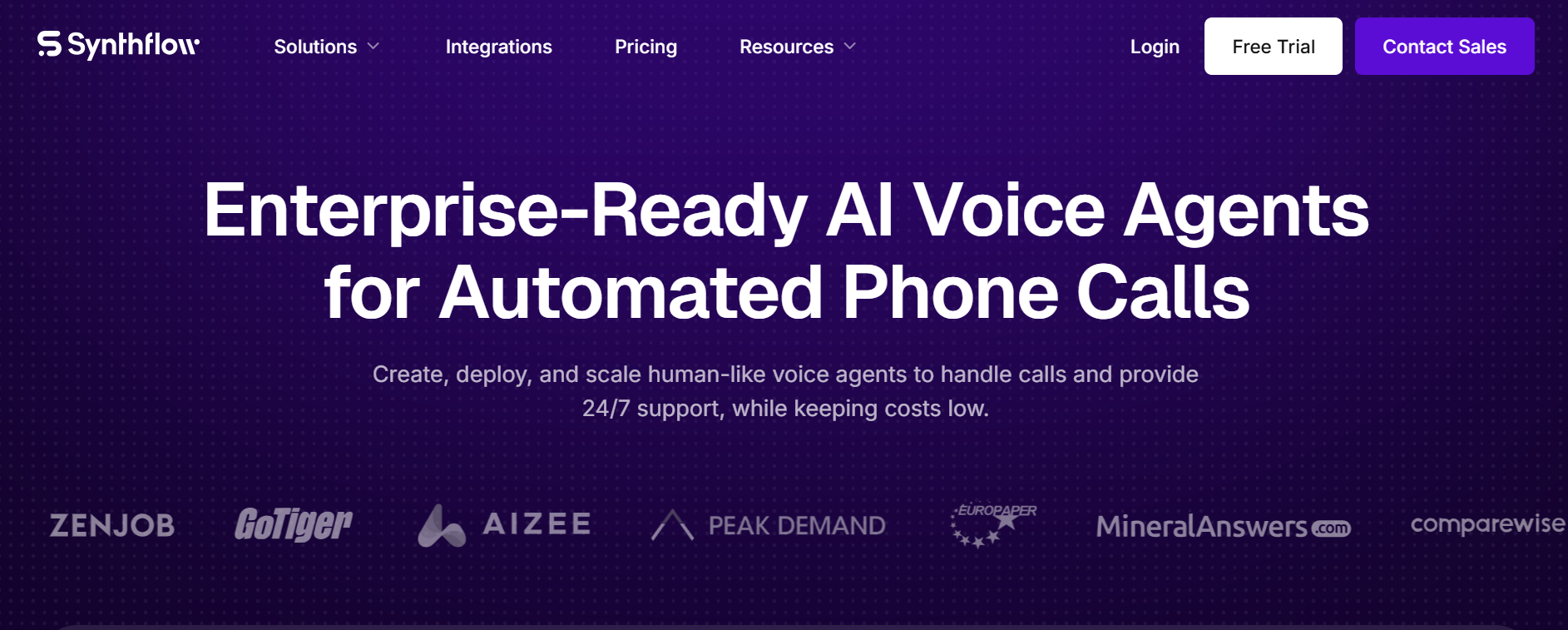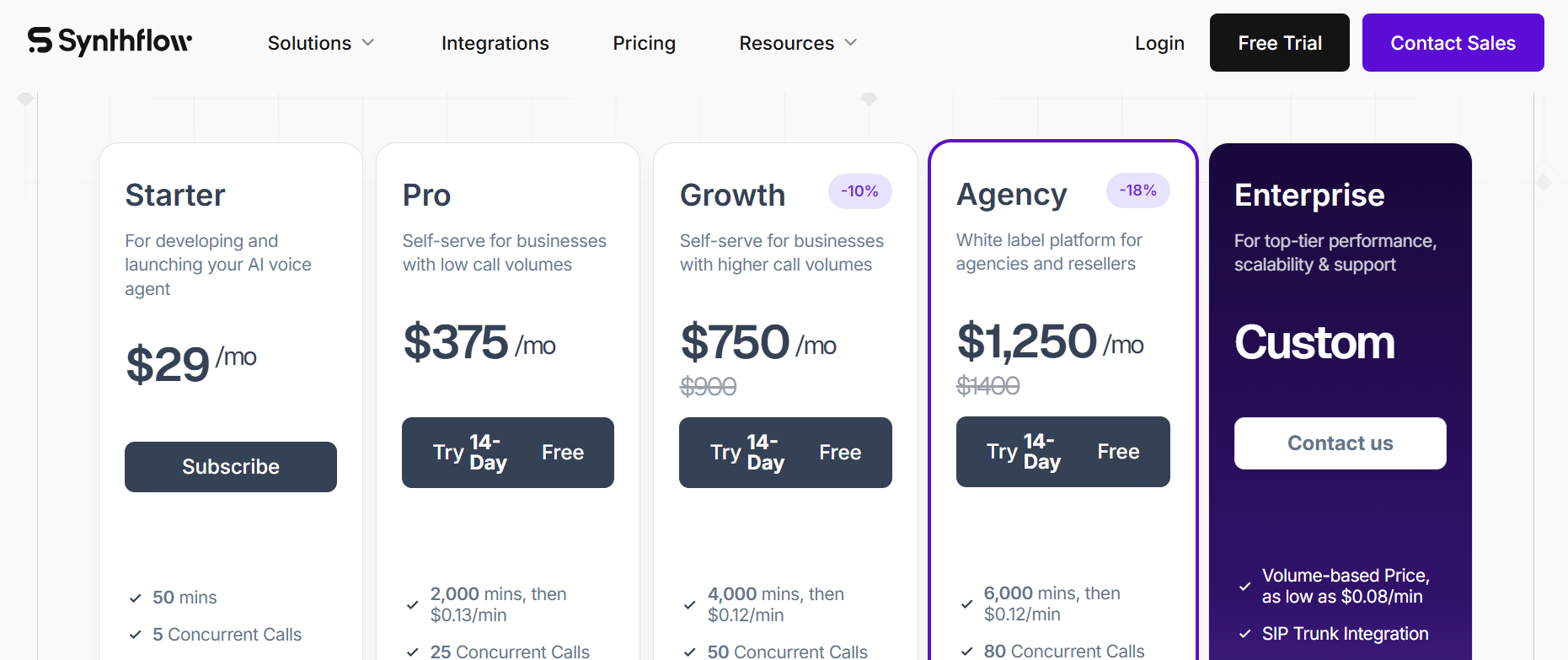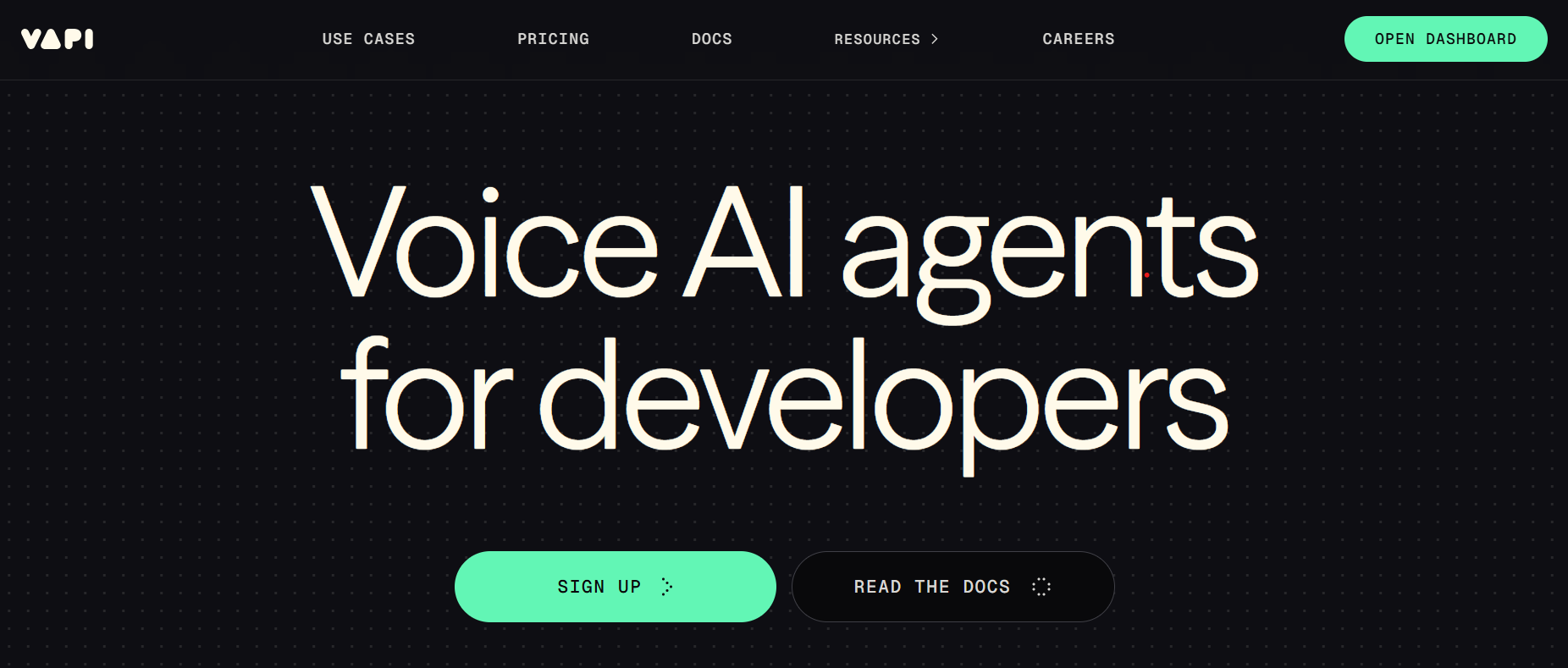.png)
Synthflow AI vs VAPI Review: AI Voice Platform Comparison for Businesses
AI voice agents now handle over 10 million calls every month across different industries. They're completely changing how businesses talk to their customers. As more companies want to automate their phone systems while keeping conversations natural, picking the right AI voice platform has become super important for success.
This detailed comparison looks at Synthflow and VAPI two top platforms that take very different approaches to voice AI automation. Synthflow works great for business users who want to get started quickly, while VAPI serves developers who need complete customization and control.
What Are AI Voice Agents?
AI voice agents combine three smart technologies that work together to create conversations that sound just like talking to a real person. Speech-to-text (STT) technology turns spoken words into text, large language models (LLM) understand what you mean and create smart responses, and text-to-speech (TTS) systems turn those responses back into natural-sounding speech.
The business benefits go way beyond just saving money. Companies using effective voice automation report up to 70% less operational costs and 60% faster customer response times. These systems work 24/7 without any human help while smoothly passing complex issues to human agents when needed.
The conversational AI platform market shows this growing popularity, with values expected to jump from $234.82 million in 2024 to $589.76 million by 2031. This growth comes from better natural language processing and more companies wanting scalable customer service solutions.
Synthflow AI: The Business-Focused Platform

Platform Overview
Synthflow has made itself the go-to solution for business users, agencies, and organizations that don't have tons of technical resources. The platform's main goal focuses on giving you a complete, ready-to-use solution that includes everything you need to launch AI voice agents at scale.
Unlike developer-focused platforms that need lots of technical work, Synthflow offers a no-code approach that lets business users, marketing teams, and agencies create smart voice agents through an easy visual interface. The platform currently powers over 10 million voice calls monthly across 30+ countries, with great results including healthcare organizations getting 60% better scheduling efficiency.
Key Features and Capabilities
The platform's no-code builder acts as your main hub for creating voice agents, offering a visual workflow designer that lets you map out conversation flows and set response rules without writing code. This approach lets you deploy working voice agents in hours instead of weeks.
Synthflow's voice capabilities feature tested voices in over 30 languages with natural-sounding speech that stays consistent across different accents and speaking styles. The platform uses OpenAI's GPT-4o model, specifically fine-tuned for conversations and optimized for quick responses.
The integration system goes beyond basic API connections to include ready-made workflows for common business situations:
- Real-time calendar booking and appointment scheduling
- CRM system integrations for lead management
- Human transfer capabilities for complex questions
- SMS follow-up and confirmation systems
- White-label options for agencies and service providers
Enterprise features include SOC2, HIPAA, and GDPR compliance certifications, 99.9% uptime guarantees, and dedicated support channels for mission-critical deployments.
Pricing Structure
Synthflow's pricing model focuses on giving you predictable, all-inclusive costs that eliminate the hassle of managing multiple vendor relationships. The platform offers five different tiers designed to fit different business sizes and usage patterns.

Extra usage costs range from $0.12-0.13 per minute, with Enterprise customers getting rates as low as $0.08 per minute for high-volume use. A big advantage of this pricing model includes all necessary components—transcription, language models, and voice synthesis—in the base price.
Strengths and Limitations
Synthflow's main strength lies in delivering enterprise-grade voice AI capabilities without needing technical expertise. The no-code approach significantly cuts implementation time, with many businesses deploying their first voice agents within days rather than weeks or months.
The platform's complete feature set eliminates the need to work with multiple vendors or manage complex technical relationships. From voice synthesis to transcription to language processing, Synthflow provides a complete stack that works seamlessly together.
However, this business-focused approach also creates certain limitations. Organizations needing deep technical customization or integration with proprietary systems may find the platform's no-code approach restrictive. The pricing structure, while transparent and predictable, may cost more for organizations that prefer to manage their own language model and transcription services.
VAPI: The Developer-First Platform

Platform Overview
VAPI has established itself as the top API-first platform for developers building advanced voice AI applications. The company's developer-first philosophy recognizes that many organizations have unique requirements that can't be addressed by one-size-fits-all solutions.
The platform provides a comprehensive set of APIs and tools that enable technical teams to build sophisticated voice agents while keeping full control over the underlying technology stack, data flow, and user experience. VAPI powers voice agents for companies ranging from innovative startups to Fortune 500 organizations, with notable implementations including FleetWorks processing over 400,000 daily calls.
Technical Capabilities
VAPI's feature architecture reflects its API-native design philosophy, with every platform capability exposed through well-documented APIs that enable programmatic control and integration. The platform offers over 1,000 configuration options, enabling developers to fine-tune every aspect of their voice agents' behavior and performance.
The "bring your own models" (BYOM) capability represents a significant advantage in the voice AI market. Rather than locking customers into specific AI providers, VAPI allows organizations to use their preferred speech-to-text, language model, and text-to-speech services. This flexibility enables businesses to optimize costs, leverage existing vendor relationships, or use specialized models.
Advanced features include:
- Tool calling functionality for external API interactions
- A/B testing capabilities for continuous optimization
- Automated testing frameworks with simulated interactions
- Multilingual support for 100+ languages
- Sub-500ms latency with 99.99% uptime guarantees
The platform's conversation management includes interrupt handling, context preservation across multiple turns, and sophisticated state management that enables natural conversational experiences even when customers change topics or provide unexpected inputs.
Pricing and Cost Structure
VAPI's pricing model reflects its developer-focused approach, offering transparent usage-based pricing that allows organizations to pay only for what they use. The platform operates on a pay-as-you-go model with separate charges for different service components.
The core platform fee is $0.05 per minute for all voice interactions, covering VAPI's hosting infrastructure, API access, and platform features. Unlike all-inclusive pricing models, VAPI charges separately for underlying AI services (speech-to-text, language models, and text-to-speech), allowing organizations to optimize costs based on their specific usage patterns.
For a typical 2,000-minute monthly usage scenario, costs would include $100 in platform fees plus $50-200 in AI service charges depending on the providers and models selected. Concurrency pricing starts with 10 included concurrent call lines, with additional lines available at $10 per line per month.
Enterprise customers receive volume-based pricing with annual contracts starting at 200,000 minutes per year, including AI service costs and custom support agreements. The platform provides $10 in free credits for new users, typically covering 150-200 minutes of usage for thorough testing.
Advantages and Challenges
VAPI's greatest strength lies in its technical flexibility and the level of control it provides to development teams. The API-first architecture enables organizations to build voice AI solutions that integrate smoothly with existing systems and workflows, rather than requiring adaptation to predetermined approaches.
The bring-your-own-models capability provides significant strategic advantages for organizations wanting to maintain control over their AI stack or leverage specialized models. This approach also enables cost optimization for high-volume users who can negotiate better rates with AI service providers.
However, VAPI's technical sophistication also creates barriers for non-technical users. Organizations without dedicated development resources may find the platform's complexity overwhelming, particularly when compared to no-code alternatives. The separate pricing for AI services, while providing flexibility, creates complexity in cost management and budgeting.
Head-to-Head Comparison
Ease of Use and Implementation
The difference in user experience between Synthflow and VAPI reflects their fundamentally different target audiences. Synthflow's guided tutorials and visual workflow designer enable business users to create functional voice agents within hours, while VAPI's developer-focused platform requires technical expertise but provides unlimited customization possibilities.
Synthflow users can typically make their first test call within an hour of account creation, leveraging ready-made templates that include optimized prompts and conversation logic. VAPI users generally require several hours to days depending on their technical requirements and integration complexity, but gain precise control over every aspect of implementation.
Feature Comparison
Feature CategorySynthflowVAPISetup ComplexityVisual, no-code interfaceAPI documentation and SDKsCustomization LevelLimited but sufficient for most use casesUnlimited programmatic controlAI Model OptionsGPT-4o optimized and includedBring your own modelsIntegration ApproachPre-built business connectorsCustom API integrationsTesting CapabilitiesBuilt-in test callingAutomated testing suites
Cost Analysis
Pricing comparison reveals different approaches to value delivery. Synthflow's all-inclusive pricing provides predictability and simplicity, while VAPI's component-based pricing offers flexibility and potential cost optimization.
For moderate usage (2,000 minutes monthly), Synthflow's Pro tier at $375 provides comprehensive capabilities with no additional charges. VAPI's equivalent would cost $100-300 depending on AI service selection, potentially offering savings for technically capable organizations willing to manage multiple vendor relationships.
High-volume users may achieve significant cost advantages with VAPI's enterprise pricing and vendor optimization capabilities, while organizations preferring predictable costs and simplified management often find better value in Synthflow's bundled approach.
When to Choose Each Platform
Synthflow is Ideal For:
Organizations that prioritize rapid deployment and ease of use will find Synthflow's approach most suitable. Small to medium-sized businesses without dedicated development resources can leverage the no-code platform to deploy sophisticated voice agents that would otherwise require months of development work.
Agencies and service providers benefit significantly from Synthflow's white-label capabilities and multi-tenant architecture. The platform enables service providers to offer voice AI solutions under their own brand while leveraging proven infrastructure and ongoing development.
Healthcare organizations operating under strict compliance requirements benefit from built-in HIPAA, SOC2, and GDPR compliance features, while real estate companies can leverage pre-built qualification workflows that have been tested across thousands of interactions.
VAPI is Better For:
Technology companies and startups with experienced development teams that need more control over customization, integrations, and cost management. It is often used in environments where technical teams can handle advanced configurations or where operations require flexibility at scale.
Better For:
- Technology companies and startups – Teams with strong development capabilities can make use of VAPI’s customization options to tailor voice AI solutions for their needs.
- Enterprises with complex integrations – The platform offers API access and integration flexibility that can support connections with proprietary systems or specialized workflows.
- High-volume operations – Businesses handling large call volumes may find value in VAPI’s bring-your-own-models approach, which can help manage costs when processing millions of minutes.
Alternative Solutions Worth Considering
Emerging Market Options
While Synthflow and VAPI represent two distinct approaches to voice AI platforms, the rapidly evolving market offers several alternatives that may better serve specific organizational needs or budget constraints. Retell AI provides a middle ground between ease of use and technical flexibility, while Bland AI specializes in ultra-human-like conversations with premium positioning.
OpenMic AI: A Cost-Effective Alternative
For organizations seeking a balance between functionality and cost-effectiveness, OpenMic AI offers a compelling alternative that challenges traditional platform trade-offs. The platform provides enterprise-grade capabilities at 40-60% lower costs than comparable platforms without compromising performance or reliability.
OpenMic AI's security-first architecture implements advanced encryption and privacy controls that exceed industry standards, while built-in ethical frameworks ensure voice agents operate within appropriate boundaries. The platform combines VAPI's API flexibility with Synthflow's ease of use, enabling both technical teams and business users to leverage the platform effectively.
For cost-conscious organizations that refuse to compromise on quality or security standards, OpenMic AI proves that cost-effectiveness doesn't require sacrificing enterprise-grade capabilities.
Ready to explore a more cost-effective voice AI solution? Book a free demo with OpenMic AI today and discover how you can reduce costs by up to 60% while maintaining enterprise-grade performance.
Explore related blogs
.png)
Voice AI for Mass Tort Lawyers: How Conversational AI Is Revolutionizing Case Intake & Client Engagement
.png)
Top 5 AI Answering Services for Law Firms in 2025 (24/7 Reception & Intake)
.png)
Top 5 White-Label Voice AI Platforms in 2025 (Best for Agencies & SaaS Providers)
Let AI Handle Your Phones So You Can Focus on Growth
Start your free trial and see how OpenMic’s AI voice agents can streamline calls, boost conversions, and deliver fast, 24/7 customer service — without hiring more staff.






.svg)